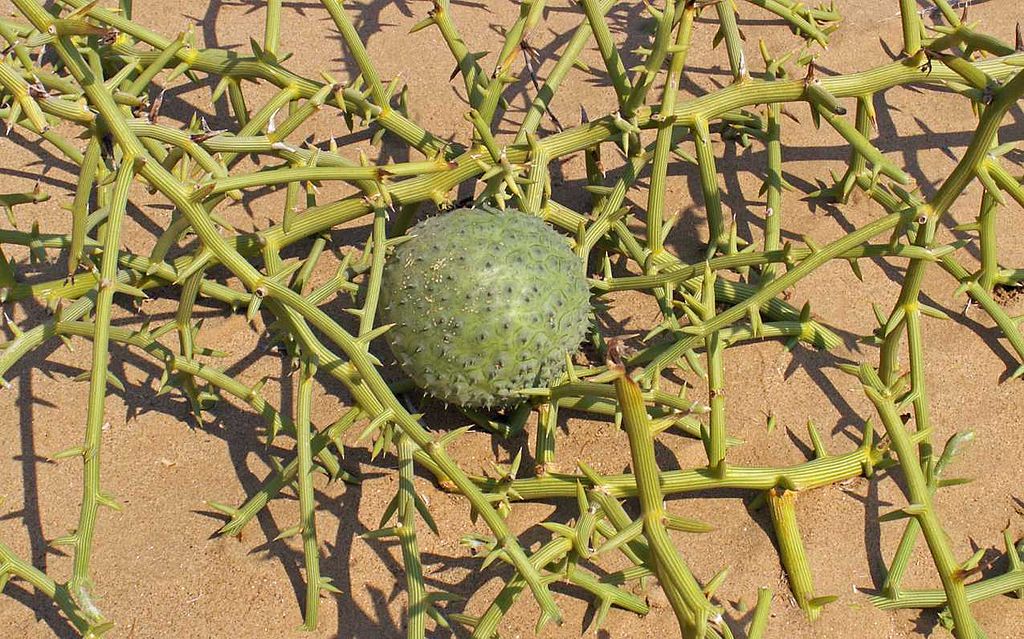Nara Melon Plants: Information About Growing Nara Melons

There is a plant that grows in the coastal region of the Namib Desert in Namibia. It is of great importance not only to the bush people of that region but is also ecologically key to maintaining the unique desert habitat. Nara melon plants grow wild in this region and are an essential food source to the indigenous Topnaar people. So what is a nara melon and what other nara bush information would be helpful when growing nara melons?
What is a Nara Melon?
Nara melon plants (Acanthosicyos horridus) are not classified as desert plants despite their growing location. Naras rely on underground water, and as such, bear deep water seeking roots. A member of the cucumber family, nara melons are an ancient species with fossil evidence dating back 40 million years. It was most likely responsible for the survival of Stone Age tribes into modern times. The plant is leafless, an adaption no doubt evolved to protect the plant from losing water through leaf evaporation. Densely tangled, the shrub has sharp spines growing on grooved stems wherein stomata occur. All parts of the plant are photosynthetic and green, including the flowers. Male and female flowers are produced on separate plants. The female blossoms are easy to recognize by the warty, swollen ovary that develops into a fruit. The fruit at first is green, then once the size of a baby’s head, turns orange-yellow with many cream colored seeds lodged in the pulp. The fruit is high in protein and iron.
Additional Nara Bush Information
The Topnaar people of this region of Namib Desert refer to the melon as !nara, with the “!” denoting a click of the tongue in their language, Nama. Nara is such a valuable source of food for these people (who eat both the nuts, which taste like almonds, and the fruit). The seeds contain about 57 percent oil and 31 percent protein. Fresh fruit may be eaten, but contains cucurbitacins. In immature fruit, high enough amounts can burn the mouth. Ripe fruit does not have that effect. The fruit is sometimes eaten raw, especially during drought, but is more often cooked down. The fruit is peeled with the peels fed to the livestock. The nara is boiled for several hours to allow the seeds to separate from the pulp. Then the seeds are taken from the pulp and dried in the sun for later use. The pulp is poured on sand or on bags and left to dry in the sun for several days into a dry flat cake. These cakes, like our fruit leather, can be stored for years as a vital food source. Since growing nara melons are characteristic of this particular area of the desert, it fulfills an important ecological niche. The plants grow only within reach of subterranean water and form high dunes by trapping sand, stabilizing the unique topography of the Namib. Nara also shelter many different types of insects and reptiles, like the dune dwelling lizard. Also, wildlife such as giraffes, Oryx, rhinos, jackals, hyenas, gerbils, and beetles all want a piece of the nara bush melon. Native people use the nara melon medicinally to treat stomach pain, facilitate healing, and to moisturize and protect skin from the sun.
How to Grow Nara Melon
The question of how to grow nara melon is a tricky one. Ideally, this plant has a niche habitat that cannot be replicated. However, it can be used in a xeriscape where conditions mimic its natural environment. Hardy to USDA zone 11, the plant needs full sun. Nara can be propagated through seed or cuttings. Space the plants 36 to 48 inches (91-122 cm.) apart and give them plenty of room to grow in the garden, as the vines can grow up to 30 feet (9 m.) wide in some cases. Again, nara melon may not be suitable for the average gardener, but those residing in an appropriate region with adequate space for this plant can give it a try. Nara will bloom mid to late summer and the blossoms are attractive to butterflies, bees, and bird pollinators.
Gardening tips, videos, info and more delivered right to your inbox!
Sign up for the Gardening Know How newsletter today and receive a free copy of our e-book "How to Grow Delicious Tomatoes".

Amy Grant has been gardening for 30 years and writing for 15. A professional chef and caterer, Amy's area of expertise is culinary gardening.
-
 Grow ‘Karl Rosenfield’ Peony Plants For The Ultimate Frilly Border Beauties And Cut Flowers
Grow ‘Karl Rosenfield’ Peony Plants For The Ultimate Frilly Border Beauties And Cut FlowersFor frilly double magenta peony petals infused with a heady fragrance, grow ‘Karl Rosenfield’ peony plants. Here’s how to cultivate the ultimate plushy blooms
By Tonya Barnett
-
 10 Common Composting Problems That Can Spoil Your Garden Gold – Plus Easy Fixes
10 Common Composting Problems That Can Spoil Your Garden Gold – Plus Easy FixesLearn how to troubleshoot common composting issues before they ruin your stash – from bad smells and bugs to materials not breaking down as they should.
By Susan Albert